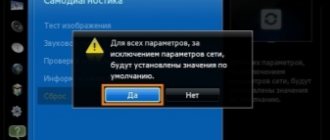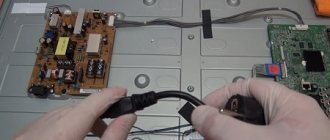Equipment has a certain service life. Once it comes to an end, users face problems. However, there are also unexpected breakdowns, but they can be eliminated under warranty, if, of course, it is still valid.
What to do if your Philips TV does not turn on? Do not rush to contact the service center; first you need to determine the cause of the malfunction. It is possible that you will be able to solve the problem yourself, saving on maintenance.
Let's look at the main causes of the malfunction. It is important to promptly determine what caused the breakdown. Based on this information, a follow-up plan is drawn up.
The power indicator is on, but the TV itself does not turn on
If the TV does not turn on, but the power indicator remains on, this means that voltage is going to the microcircuit, and therefore the problem should not be looked for inside the TV device.
In this case, you should first start the TV via the remote control. If there is no reaction, then press the start button on the front panel.
This simple diagnostic will be enough to find out the cause of the breakdown - the device turned on, which means the problem is in the Philips remote control.
This problem can be quickly resolved without calling a technician at home in the following ways:
- Sometimes the reason for the breakdown is trivial - the batteries run out. In this case, you just need to replace them with new ones and try pressing the power button again.
- The contacts in the battery compartment may have come loose. If you have experience working with a soldering iron, then the problem can also be fixed in a few minutes by placing the cable in its proper place.
- There is a possibility that the wires have been oxidized. In this case, you need to clean the contacts by moistening a piece of cloth or cotton wool with a small amount of alcohol.
- Sometimes the buttons on the remote control simply get stuck, and therefore the device stops responding to commands. In this case, you need to press the power button several times to get it into place. A more reliable way is to disassemble the control panel and wipe the contacts with a cotton pad soaked in alcohol.
- If liquid has recently been spilled on the remote control, you need to disassemble it and dry the main chip.
If none of the methods described above helped to get rid of the problem and the TV device still does not respond to the remote control, then it is advisable to replace the remote control.
But this will only work if the indicator is on. For other situations, we will look at other methods of repairing a Philips TV.
Philips won't turn on but the power light is blinking
It is immediately necessary to clarify that blinking and constant lighting of the indicator indicates completely different types of breakdowns, and therefore problems with the remote control can be immediately ruled out. If the TV does not turn on, but the power indicator is constantly blinking, then it is advisable to take the equipment for repair, since the malfunction of the device will depend on the amount of flickering.
This is a kind of error code that the technician must detect (a common malfunction on the Philips 32PFL3605 TV).
But you can try to fix the defect yourself, based on the most common breakdowns when the power indicator blinks (when the TV screen remains black):
- There is an easy way to try to fix a TV device at home - simply unplug the TV from the mains, and after disconnecting it, after a few minutes, reconnect it to the outlet. It sounds simple, but sometimes a Philips glitch can be fixed using this method.
- One of the most common reasons for the indicator blinking when the TV is not working is a breakdown in the power supply. If you have experience in repairing television equipment, you can try to replace the capacitors yourself, rather than the entire unit. Sometimes the problem can be solved this way. If you have no experience, then you can install a new unit entirely or take the TV to a service center.
Important! When disassembling the TV, it is strictly forbidden to try to disassemble the matrix yourself. This is the most important and most expensive part, which costs almost as much as the entire device.
Table with Philips TV fault codes
This bastard winks at me three times, I can’t Google anywhere what it means.
Alexleon4
:
Following the link, my computer says: The page you were on is trying to redirect you to an invalid URL.
If I copy the link and paste it into the browser, it will download. If I just poke it, it also gives an error.
This boat is not the same chassis, this model is indicated in the manual for Q552.1E LA
There is a simple blinking LED procedure for board Level repair (home repair) so called LAYER 1 errors Next to the existing errors which are LAYER 2 errors (see Table 5-2). – LAYER 1 errors are one digit errors. – LAYER 2 errors are 2 digit errors. In protection mode. – From consumer mode: LAYER 1. – From SDM mode: LAYER 2. • Fatal errors, if I2C bus is blocked and the set reboots, CSM and SAM are not selectable. – From consumer mode: LAYER 1. – From SDM mode: LAYER 2. • In CSM mode. – When entering CSM: error LAYER 1 will be displayed By blinking LED. Only the latest error is shown. • In SDM mode. – When SDM is entered via Remote Control code or the Hardware pins, LAYER 2 is displayed via blinking LED. • Error display on screen. – In CSM no error codes are displayed on screen. – In SAM the complete error list is shown.
It says 3 blinks, this is either 12V or an inverter
Alex78
:
Written 3 blinks are either 12V or inverter
There is a simple flashing LED procedure on board Level of repair (home repair), the so-called Layer 1 errors Next to the existing errors, which are LAYER 2 errors (see Table 5-2). – Error level 1 one digit errors. – Error level 2 2 error digits. In protection mode. – From consumer mode: Layer 1. – From SDM mode: Layer 2. • Fatal errors if the I2C bus is blocked and the CSM and Sam reset set is not selected. – From consumer mode: Layer 1. – From SDM mode: Layer 2. • In CSM mode. – When entering CSM: Layer 1 error will be indicated by LED flashing. Only the last error is shown in the figure. • In SDM mode. – When SDM is entered through a remote control or Hardware pin code, LAYER 2 is displayed with a flashing LED. • Screen display error. – In CSM, error codes are not displayed on the screen. – In SAM The complete list of errors is shown in the figure.
Thanks, Alex78, But is it possible to have a drawing with a complete list of errors? 12v seems to be there
Radio Forum is a site dedicated to discussing electronics, computers and related topics.
Repairing Philips LCD TVs has a number of features characteristic of this brand of TV. Philips LCD TVs have a function for indicating errors in the operation of the TV system, as a result of which the TV breaks down. The number of cyclic blinks of the indicator corresponds to the TV error code.
The indicator is not lit
If the indicator does not light up and the Philips TV does not turn on, you need to check the voltage going to the microcircuit; perhaps it is simply missing. In certain situations, the problem can be easily fixed at home.
First you need to check the power supply. To do this, place the indicator screwdriver in the socket and check whether there is any voltage at all. Sometimes the cause of the malfunction lies not in the TV at all, but in the outlet or electrical network.
When it turns out that the network is OK, we proceed to the next step, which can be done at home. Sometimes the TV stops turning on because the power button is simply not active.
On all Philips models, there is a button near the LED that turns off the screen. You need to try clicking on it. Afterwards you can control the device using the remote control.
Another common cause of malfunction is the TV unit going into sleep mode. To turn off the power saving function, you must press the AV/TV button on the remote control. If the problem cannot be resolved using these methods, it is advisable to contact a service center, since the breakdown turned out to be more serious and cannot be fixed on your own.
Checking that the cable is connected correctly
Many users realize that a problem has arisen when the LED continuously blinks in different colors, but the TV does not turn on. In this case, it is necessary to check the functionality of the main control blocks. If the indicator flashes randomly, without a certain sequence, this also indicates damaged hardware units.
Non-working external components also cause the TV screen to be black. This is due to the device's power line, which needs to be checked first. You will first need to make sure that the correct cable connection is established between external sources and the TV. This will allow the user to understand if there is a connection problem. Therefore, it is necessary to disconnect all cables from the device, reinstall them tightly and connect them correctly to prevent loose connections. In addition, you need to make sure that the power cable and power supply are in good working order.
After completing this stage, they begin to check the functionality of the cables in order to understand whether they are working or showing a malfunction. The coaxial cable and HDMI must be in good condition. If the user finds a damaged cable, they need to take another one and check if the problem is resolved. You can also try switching from one HDMI port to another to see if the port works well. If it still does not respond, be sure to move on to the next stage of diagnosis until a solution is found.
Makes strange noises
If the TV suddenly begins to make extraneous sounds during operation, but the picture is transmitted to the monitor as before, then the reason is poor-quality assembly. In most cases, the problem lies in the case, the parts of which creak.
Unfortunately, the only way to eliminate extraneous sounds is to disassemble and reassemble the case. But you shouldn’t count on much improvement - the parts will probably start making similar sounds again.
Important! Interference can also occur due to incorrect settings or batteries.
Signs of another malfunction - the TV began to turn on with a delay, periodically turns off on its own, and extraneous sounds appear.
This is a serious breakdown, and therefore it is necessary to immediately take the TV device to a service center. If you can’t turn on the TV or the screen gradually goes dark, this is a clear sign of a malfunction.
Therefore, it is important to pay attention to the accompanying “symptoms” in order to carry out repairs on your own.
Any equipment breaks down sooner or later, but sometimes you can fix it yourself at home. About what to do if the Phyllis TV does not turn on later in the article.
The power indicator is on, but the TV itself does not turn on
If the TV does not turn on, but the power indicator remains on, this means that voltage is going to the microcircuit, and therefore the problem should not be looked for inside the TV device.
In this case, you should first start the TV via the remote control. If there is no reaction, then press the start button on the front panel.
This simple diagnostic will be enough to find out the cause of the breakdown - the device turned on, which means the problem is in the Philips remote control.
This problem can be quickly resolved without calling a technician at home in the following ways:
- Sometimes the reason for the breakdown is trivial - the batteries run out. In this case, you just need to replace them with new ones and try pressing the power button again.
- The contacts in the battery compartment may have come loose. If you have experience working with a soldering iron, then the problem can also be fixed in a few minutes by placing the cable in its proper place.
- There is a possibility that the wires have been oxidized. In this case, you need to clean the contacts by moistening a piece of cloth or cotton wool with a small amount of alcohol.
- Sometimes the buttons on the remote control simply get stuck, and therefore the device stops responding to commands. In this case, you need to press the power button several times to get it into place. A more reliable way is to disassemble the control panel and wipe the contacts with a cotton pad soaked in alcohol.
- If liquid has recently been spilled on the remote control, you need to disassemble it and dry the main chip.
If none of the methods described above helped to get rid of the problem and the TV device still does not respond to the remote control, then it is advisable to replace the remote control.
But this will only work if the indicator is on. For other situations, we will look at other methods of repairing a Philips TV.
Philips won't turn on but the power light is blinking
It is immediately necessary to clarify that blinking and constant lighting of the indicator indicates completely different types of breakdowns, and therefore problems with the remote control can be immediately ruled out. If the TV does not turn on, but the power indicator is constantly blinking, then it is advisable to take the equipment for repair, since the malfunction of the device will depend on the amount of flickering.
This is a kind of error code that the technician must detect (a common malfunction on the Philips 32PFL3605 TV).
But you can try to fix the defect yourself, based on the most common breakdowns when the power indicator blinks (when the TV screen remains black):
- There is an easy way to try to fix a TV device at home - simply unplug the TV from the mains, and after disconnecting it, after a few minutes, reconnect it to the outlet. It sounds simple, but sometimes a Philips glitch can be fixed using this method.
- One of the most common reasons for the indicator blinking when the TV is not working is a breakdown in the power supply. If you have experience in repairing television equipment, you can try to replace the capacitors yourself, rather than the entire unit. Sometimes the problem can be solved this way. If you have no experience, then you can install a new unit entirely or take the TV to a service center.
Important! When disassembling the TV, it is strictly forbidden to try to disassemble the matrix yourself. This is the most important and most expensive part, which costs almost as much as the entire device.
Makes strange noises
If the TV suddenly begins to make extraneous sounds during operation, but the picture is transmitted to the monitor as before, then the reason is poor-quality assembly. In most cases, the problem lies in the case, the parts of which creak.
Unfortunately, the only way to eliminate extraneous sounds is to disassemble and reassemble the case. But you shouldn’t count on much improvement - the parts will probably start making similar sounds again.
Important! Interference can also occur due to incorrect settings or batteries.
Signs of another malfunction - the TV began to turn on with a delay, periodically turns off on its own, and extraneous sounds appear.
This is a serious breakdown, and therefore it is necessary to immediately take the TV device to a service center. If you can’t turn on the TV or the screen gradually goes dark, this is a clear sign of a malfunction.
Therefore, it is important to pay attention to the accompanying “symptoms” in order to carry out repairs on your own.
Televisions, like any technology, have their drawbacks and eventually break down. Why, it is impossible to give an exact answer why the Philips TV does not turn on or does it on its own without preliminary diagnosis. As a rule, plasma works flawlessly for a long time, easily broadcasting digital, cable and regular channels. LCD malfunctions make themselves felt suddenly, but often they turn out to be easy to fix with your own hands.
Main reasons
The first thing you should pay attention to is the power cable. It is possible that it was not plugged into the outlet enough. Make sure it is in the optimal position and not pinched by heavy objects.
Then inspect the outlet itself or the extension cord where the cable was connected. Pay attention to the tightness of the contacts. Being strongly unclenched, weak contact occurs, which is why the device lacks power for full operation. This can also cause the socket to heat up and the contacts to burn, with a high probability of a short circuit.
Sometimes the LCD TV does not turn on the first time. Many people mistakenly begin to look for a problem in the plasma hardware, when in fact, the reason may lie in the control panel. The culprit is dead batteries or a damaged infrared port.
To testify that the remote control is broken, point the emitter at the smartphone’s camera; if the light does not blink, it means the batteries are low or there are other faults.
It is quite possible to start the TV from the control button on the body.
Inspect the receiver itself; it is often found to be in poor condition as a result of a fall or mechanical damage, for example, a ball hitting the screen.
If the equipment does not turn on at all, and the LED (light bulb on the body) is still blinking, you should study the error codes of Philips TVs. They are included in the user manual included in the kit, which helps you determine the problem yourself. For example, 3 consecutive flickers indicate a critical state of the power supply, etc.
Other breakdowns include:
- Problems with the firmware.
- Voltage surges.
- Power supply malfunction.
- Damaged inverter.
- Human factor.
Philips TV repair
Philips TVs are known all over the world and have been popular in the Russian market for a long time.
In Russia, their active sale began in the early 90s and continues today. Since 2011, Philips TVs sold in the Russian Federation have been manufactured in St. Petersburg, pos. Shushary of the Chinese corporation TPV Technologies. Unfortunately, Philips lost its former European quality of household appliances due to the transfer of the brand and 70% of production capacity. In repair, Philips TVs, until a certain time, had their own characteristics due to differences in circuit solutions from Japanese, Korean and Chinese developers. It was also possible to observe differences in the quality of the element base used in the production of blocks and modules. In recent years, this line has been gradually erased and modern Russian-assembled Philips LED TVs are no longer superior in quality to inexpensive Chinese brands.
Typical defects of Philips CRT TVs
Philips televisions with picture tube (CRT) rarely come in for repair, but a huge amount of practice in their repair has been accumulated in all service centers over many years of service. In most cases, typical malfunctions are associated with defects among individual elements specific to a given manufacturer. Masters will remember the breakdown of the decoupling chokes in the horizontal scan driver and the metal film capacitors in the circuit of horizontal deflection coils for a long time. In recent years, CRT TVs with dried electrolytic capacitors in B+ scan power filters have been more often repaired.
Typical defects of Philips LCD and LED TVs
There are quite a few models and chassis of Philips TVs, and each chassis has its own typical faults, which are not possible to describe in one article, so we will point out the most popular defects.
power unit
External manifestations: The TV does not turn on the first time, but after several attempts it still enters operating mode. In this case, the filter capacitors of the secondary rectifiers of the flyback converter of the switching power supply are usually faulty. They need to be replaced. The defect is more often observed in Philips TVs with diagonals up to 22 inches, mainly made in Poland.
Display backlight
External manifestations: Strong color distortions. The image appears to be in negative and somewhat resembles a signal from an infrared camera (thermal imager). In this case, there are two options to consider. In both cases, the problem is related to a change in the V-com voltage value in the timing controller (T-CON). 1. The panel code is set incorrectly. The problem can be solved by installing the necessary options in the TV’s service mode (Service Mode). 2. The buffer amplifier chip in the gamma correction unit is faulty. The gamma corrector needs to be repaired (replacement of the AS15F or AS19F chip). The defect is observed in certain types of panels manufactured by Samsung.
Self-diagnosis
External manifestations: The indicator on the front panel is blinking. The TV is faulty and is in self-diagnosis mode. The number of blinks per period indicates to specialists the node in which to look for a problem. A table with fault codes is provided by manufacturers to service centers in special documentation.
Motherboard SSB (MainBoard)
External manifestations: The indicator on the front panel flashes 2 times. More often, the malfunction occurs in SMART models of 1912-1913 assembled on the QFU2.1E LA and QFU1.2E LA chassis. The defect is caused by overheating of the processor. Repairing the SSB board in such cases is not always possible; more often it needs to be replaced.
Models with QFU2.1E LA
32PFL6007H/12, 32PFL6007K/12, 32PFL6007T/12, 32PFL6087H/12, 32PFL6087K/12, 32PFL6087T/12, 37PFL6007H/60, 37PFL6007H/12, 37PFL6007K/1 2, 37PFL6007T/12, 37PFL6777H/12, 37PFL6777K/12, 42PDL6907H/ 12, 42PDL6907K/12, 42PDL6907T/12, 42PFL6007H/12, 42PFL6007H/60, 42PFL6007K/12, 42PFL6007T/12, 42PFL6007T/60, 42PFL6057H/12, 42PFL605 7H/60, 42PFL6057K/12, 42PFL6057T/12, 42PFL6057T/60, 42PFL6067H/12, 42PFL6067H/60, 42PFL6067K/12, 42PFL6067T/12, 42PFL6067T/60, 42PFL6097H/12, 42PFL6097H/60, 42PFL6097K/12, 42PFL6097T/1 2, 42PFL6097T/60, 42PFL6687H/12, 42PFL6687H/60, 42PFL6687K/ 12, 42PFL6687T/60, 42PFL6877H/12, 42PFL6877H/60, 42PFL6877K/12, 42PFL6877T/12, 42PFL6877T/60, 47PDL6907H/12, 47PDL6907K/12, 47PDL690 7T/12, 47PFL6007H/12, 47PFL6007H/60, 47PFL6007K/12, 47PFL6007T/12, 47PFL6007T/60, 47PFL6057H/12, 47PFL6057H/60, 47PFL6057K/12, 47PFL6057T/12, 47PFL6057T/60, 47PFL6067H/12, 47PFL6067H/6 0, 47PFL6067K/12, 47PFL6067T/12, 47PFL6067T/60, 47PFL6097H/ 12, 47PFL6097H/60, 47PFL6097K/12, 47PFL6097T/12, 47PFL6097T/60, 47PFL6687H/12, 47PFL6687H/60, 47PFL6687K/12, 47PFL6687T/60, 47PFL687 7H/12, 47PFL6877H/60, 47PFL6877K/12, 47PFL6877T/12, 47PFL6877T/60, 55PFL6007K/12, 55PFL6007T/12, 55PFL6097H/12, 55PFL6097K/12, 55PFL6097T/12.
Models with QFU1.2E LA
40PFL8008K/12, 40PFL8008S/12, 40PFL8008S/60, 42PFL6008H/12, 42PFL6008K/12, 42PFL6008S/12, 42PFL6008S/60, 42PFL6158K/12, 42PFL6158S/1 2, 42PFL6188K/12, 42PFL6188S/12, 42PFL6198K/12, 42PFL6678K/ 12, 42PFL6678S/12, 42PFL7008H/12, 42PFL7008K/12, 42PFL7008S/12, 42PFL7008S/60, 42PFL7008T/12, 42PFL7108H/12, 42PFL7108K/12, 42PFL710 8S/12, 42PFL7108S/60, 42PFL7108T/12, 46PDL8908S/12, 46PDL8908S/60, 46PFL8008K/12, 46PFL8008S/12, 46PFL8008S/60, 46PFL8008S/98, 47PFL6008H/12, 47PFL6008K/12, 47PFL6008S/12, 47PFL6008S/6 0, 47PFL6158K/12, 47PFL6158S/12, 47PFL6188K/12, 47PFL6188S/ 12, 47PFL6198K/12, 47PFL6678K/12, 47PFL6678S/12, 47PFL7008H/12, 47PFL7008K/12, 47PFL7008S/12, 47PFL7008S/60, 47PFL7108H/12, 47PFL710 8K/12, 47PFL7108S/12, 47PFL7108S/60, 55PDL8908D/78, 55PDL8908S/12, 55PDL8908S/60, 55PDL8908S/98, 55PFL6008H/12, 55PFL6008K/12, 55PFL6008S/12, 55PFL6008S/60, 55PFL6008T/12, 55PFL6158K/1 2, 55PFL6158S/12, 55PFL6188K/12, 55PFL6188S/12, 55PFL6198K/ 12, 55PFL6678K/12, 55PFL6678S/12, 55PFL7008H/12, 55PFL7008K/12, 55PFL7008S/12, 55PFL7008S/60, 55PFL7108H/12, 55PFL7108K/12, 55PFL710 8S/12, 55PFL7108S/60, 55PFL8008K/12, 55PFL8008S/12, 55PFL8008S/60, 60PFL6008H/12, 60PFL6008K/12, 60PFL6008S/12, 60PFL6008S/60, 60PFL8708S/12, 60PFL8708S/60, 65PFL9708S/12, 65PFL9708S/6 0, 84PFL9708S/12, 84PFL9708/78.
The firmware has crashed
It is worth noting that software fails more often than one might think. The problem lies in unstable power supply or sudden outages from the power supply. As a result, the memory module burns out, which leads to erasing the operating system.
After the firmware flashes, a black screen is observed, Philips equipment will not start from the remote control, stops connecting to Wi-Fi, or begins to freeze on the introductory screensaver. In rare cases, the image “shifts” to one side.
By the way, it is not necessary to go to the experts, because it is possible to carry out repairs yourself. The only thing is that you need to have some experience in working with software and be sure that all the “brakes” appeared due to the software.
If, after updating the software, the Philips TV receiver does not search for channels, turns on and turns off immediately, then this indicates “symptoms” of a hardware failure. Well, if the TV does not respond to commands in any way, all that remains is to take it to the service center.
Attention! Before flashing the firmware, find the exact model name of your TV receiver. An error of just a few letters can lead to a complete violation of the launch algorithms. You only need to download software from the official website of the device manufacturer.
Power surges
Due to power surges, individual power supplies on the main board stop working. Often they are the ones that cause the loss of image and lack of sound, even if there is video on the screen. The catch is that an electrical circuit without stabilizers quickly becomes unusable.
Initially, this is characterized by minor malfunctions in the operating system. At first, they can be easily eliminated by using a full reboot, disconnecting the equipment from the power source. A little later, if the drops and jumps do not stop, the electronics will stop interacting with the control panel, stop seeing the flash drive, or even cause a “software crash.” Only a technician at a service center can cope with restoring the functionality of the television receiver.
Note! Take care of the safety of your devices by purchasing surge protectors or stabilizers. Such insignificant costs will help protect expensive Philips equipment from frequent breakdowns.
power unit
The Philips TV's power supply is the weakest component of the system. It fails due to the capacitors losing their tightness (so-called “swelling”). The first signs of a possible breakdown are a whistle or squeak when the device is turned on. Not everyone is alarmed by this, which ultimately leads to a serious malfunction of the device, including its complete replacement.
A power supply malfunction is characterized by loss of images, active flickering of the backlight and reasonable TV shutdown. Symptoms may also vary depending on the model. So, the same whistle makes itself felt if:
- The capacitors are shorted.
- The microcircuits are broken.
- Transistors burned out.
Of course, something like this is very rare in modern devices. It is not recommended to look for the source of noise on your own, because having disassembled the case into its main parts, without proper practice it is easy to hook other, no less important parts of the overall system. The best solution in this situation would be to visit a workshop with a full diagnosis of the device.
Often, fluctuations in power supply lead to damage to the central processor. And since it comes only with a board, repairs will cost several times more than buying a power supply unit alone.
Error code 2 Led tv Philips
The indicator periodically blinks 2 times, signaling an error, which may differ for Philips TVs on different chassis. Repair of Philips TVs with QFU2.1E LA chassis. A spontaneous cyclic reboot (turning the TV on and off) with error code 2 in standby mode on Philips 6 series TVs on the QFU 2.1E LA chassis, for example, Philips 42pfl6877/60, 42pfl6007t/60 or 47pfl6008, is clearly related to motherboard malfunction. In the service menu (SDM mode), the error indication is 53. The alarm function of the TV system in case of malfunctions of the TV, which is embedded in the processors of certain brands and models of TVs, including Philips, is discussed in the article about TV error codes. Restoring main during the repair of Philips LCD TVs of these models is quite a complex and expensive job. Typically, replacement and firmware are performed in a pair of nand flash and processor. Finding a new QFU2.1E LA motherboard is a problem. There is no guarantee that a used copy of the main board QFU2.1E LA has not been restored. BGA contacts of a processor or nand flash memory chips can be temporarily restored by heating the chips. In this case, this is not a panacea, because after some time the TV malfunction is highly likely to recur. The reason for the relapse is the high thermal sensitivity of the processor. To remove heat from the processor, a standard aluminum radiator is not always enough. (Overheating of the TV processor.) Let's look at one of the ways to restore the motherboard processor using the example of repairing a Philips 42pfl6007t/60 TV.
Repair main board 310431365664
The chassis of the faulty Led TV Philips 42pfl6007t/60, which did not turn on and signaled error 2, is QFU2.1E LA. The TV worked for about 5 years, which corresponds to the service life declared by the manufacturer. This is a good indicator. Usually the processor on this chassis fails after 2-3 years of use. Heating the processor with a hairdryer revealed that the balls (BGA contacts) had fallen off. After the processor warmed up, the TV's functions were restored. Together with the client, it was decided not to use the classic and rather expensive repair method for this main board malfunction (rebol), but to install additional cooling of the processor. As a cooler, the telemaster used a low-power fan from a PC, which was powered from 12 V in the main board circuit. To install the fan above the processor, a square cutout was made in the case cover. The revision gave a positive result. After 6 months (repair warranty period), the Philips 42pfl6007t/60 TV continues to work properly.
Error code 2 Philips Led TV on QFU1.2E LA chassis
At the same time, on Philips TVs on the QFU1.2E LA chassis, for example, Philips 47PFL6008S/60, 42PFL6678S/12, two indicator signals may indicate a faulty power supply. Repairing the power supply of a Philips TV is much easier and cheaper than repairing or replacing the motherboard of a Philips TV.
Contacting TV service: Philips 32pfl5405h/60 TV does not turn on. The indicator blinks 2 times. TV diagnostics, which were carried out at the client’s home, confirmed a malfunction of the motherboard 3104 313 64026. Chassis Q 552.1E LA. If repairing the main board of a Philips 42pfl6877/60 TV makes sense due to the fact that, firstly, it is not easy to find a replacement and, secondly, if there is a used copy, then it will definitely cost more than repair, then in the event of a malfunction of the main Philips 32pfl5405h/60 TV board repair will cost more than replacement. Finding main board 3104 313 64026 is much easier. This Philips TV motherboard is relatively inexpensive. In any case, the replacement will be cheaper than labor-intensive and lengthy repairs without a 100% guarantee.
Error codes for PHILIPS TV chassis L01.2 E AA Philips L01.2 E AA chassis error codes
Code Description Possible causes and solutions
No errors Everything is fine
1 X-ray protection The voltage on the aquadag of the kinescope is too high (only for models supplied in the USA)
2 Horizontal scanning protection The signals ЭНТ_о, EHT_info are active. Synchronization pulses do not pass through or are missing from the synchronization unit. Transistors 7402, 7401, 7403, 7404 or elements providing their mode are faulty
3 Vertical scan protection V_guard mode is active. The TDA8359/TDA9302 chip is faulty. No voltage ±13V
4 Stereo decoder error Data exchange between the microprocessor and the 7831 stereo decoder via the I2C bus is broken. The stereo decoder is faulty or the bus signals are not reaching it.
5 Reset signal error. Power protection +8V Reset signal error when power is turned on. Overload on +8V circuit
6 General I2C digital bus error The SCL or SDA buses are shorted to common. The SCL and SDA buses are closed to each other. Bus load resistors are broken (the microprocessor has open-collector outputs).
7 Overload protection Active Power Down signal. Malfunction in the 4-12 V circuit. Check the serviceability of UMZCH 7901 (7902), transistor 7561.
8 Screen correction protection (E/W) For widescreen TVs only. Check the serviceability of the transistor 7606 (A7) and its external elements.
9 EEPROM error Communication on the I2C bus between the EEPROM and the microprocessor is broken. If such a malfunction occurs, an internal EEPROM error may occur.
10 Tuner error when working with the I2C bus Tuner 1000 is faulty. Bus signals do not reach the tuner.
There is no supply voltage to the tuner.
11 Black Level Protection The black level is not set. Check the serviceability of the video amplifiers on the kinescope board and the kinescope.
Inverter power
Following the power supply, the inverter most often needs to be replaced. According to its structure, it performs a number of useful functions, without which it is impossible to imagine the stable functioning of the television receiver.
- Firstly, it converts DC voltage into AC voltage.
- Secondly, the responsibility for changing brightness lies on its “shoulders”.
- Thirdly, the inverter is responsible for protection against network overload and short circuits.
A clear sign of inverter failure is:
- Changes in screen brightness, sometimes it turns off completely or goes completely dark.
- Backlight glare when the network indicator remains on, but does not respond to the control panel.
- The TV receiver does not start after a long period of inactivity.
- The backlight behaves strangely, stays on after turning off or refuses to start at all.
- There is sound, but no picture.
Only diagnostics will help you finally understand that it is the inverter that has failed. It is under no circumstances recommended to carry it out yourself, because without special knowledge and practice, there is a possibility of damaging important radio components.
Additionally, make sure that the antenna connected to the TV input is grounded. Otherwise, there is a risk of losing equipment due to a severe thunderstorm.
Human factor
The most underrated option of all the ones offered. Speaking from the beginning, it is impossible to ignore the fact that almost all people do not use the operating instructions for equipment, including television sets. This leads to a number of misunderstandings about how exactly the equipment should be used, where to connect the wires, or how to start the on timer so that the device does not suddenly start up in the middle of the night.
Simple inexperience and lack of knowledge leads to contacting the service center with complaints about lack of signal from the antenna or problems with HDMI detection. Things are much worse when an incompetent buyer decides to replace burnt parts himself. Experts have long been paying attention to the mandatory presence of technical education or experience to interact with TV electrical circuits. Therefore, do not bet on the health of your plasma, but rather seek help from qualified professionals.
Test a different electrical outlet
Do not use any type of voltage stabilizer for this test and try using a different outlet to make sure the outlet you are using is optimal for your TV. Note: Make sure the outlets tested are working properly. Try another electronic device to check, for example, that the power supply voltage is sufficient.
If the TV starts, you need a working power source for the TV. Contact a service company or electrician if you suspect that the power outlet is faulty.
If the TV does not start, go to step 4.











